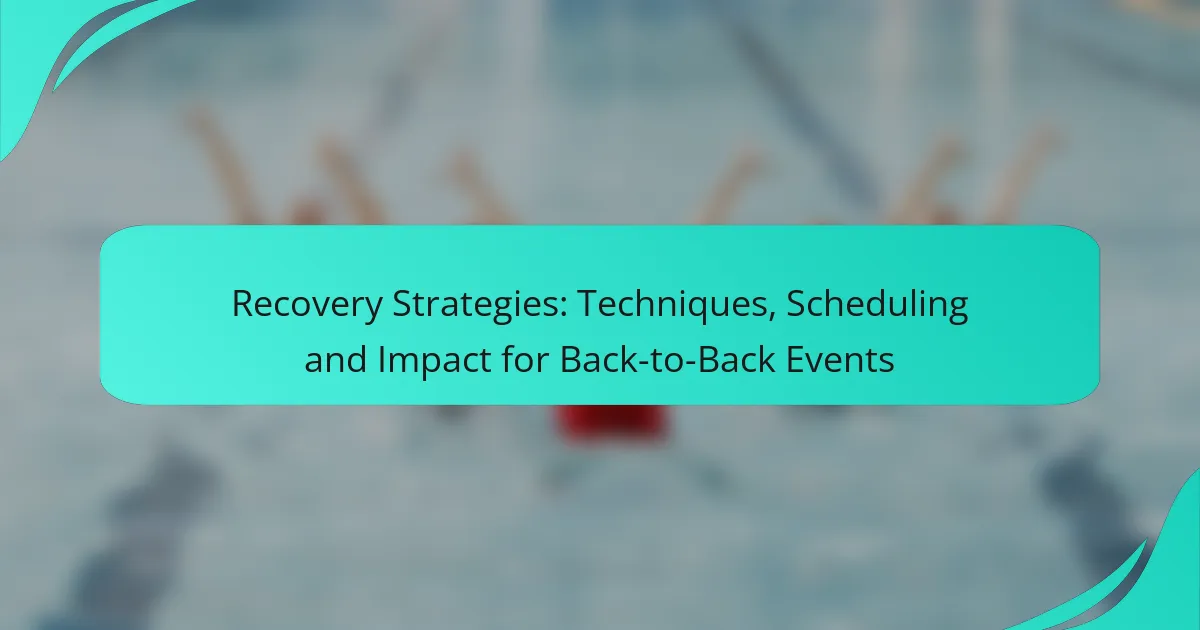Recovery strategies for back-to-back events are essential for maintaining peak performance and overall well-being. By integrating physical, nutritional, and mental techniques, individuals can effectively mitigate fatigue and enhance their recovery process. Proper scheduling of rest and recovery activities is crucial to prevent burnout and ensure readiness for subsequent challenges.

What are effective recovery strategies for back-to-back events?
Effective recovery strategies for back-to-back events include a combination of physical, nutritional, and mental approaches to ensure optimal performance and well-being. These strategies help mitigate fatigue, enhance recovery, and prepare individuals for subsequent events.
Active recovery techniques
Active recovery techniques involve low-intensity exercises that promote blood flow and muscle recovery without adding significant strain. Activities like light jogging, cycling, or swimming can help alleviate soreness and stiffness after intense events.
Incorporating 10-30 minutes of active recovery into your routine can be beneficial. Consider engaging in activities that you enjoy to maintain motivation and consistency.
Nutrition-focused recovery
Nutrition plays a crucial role in recovery, especially after back-to-back events. Consuming a balanced meal or snack rich in carbohydrates and protein within 30-60 minutes post-event can replenish glycogen stores and support muscle repair.
Focus on whole foods like lean meats, whole grains, fruits, and vegetables. A practical guideline is to aim for a ratio of 3:1 carbohydrates to protein to maximize recovery benefits.
Rest and sleep optimization
Rest and sleep are vital for recovery, as they allow the body to repair and rejuvenate. Aim for 7-9 hours of quality sleep per night, and consider short naps of 20-30 minutes during the day if needed.
Establishing a consistent sleep schedule and creating a restful environment can enhance sleep quality. Avoid screens and stimulants before bedtime to promote better rest.
Hydration strategies
Staying hydrated is essential for recovery, especially during back-to-back events. Dehydration can impair performance and prolong recovery times. Aim to drink water regularly throughout the day, and consider electrolyte-rich beverages after intense activities.
A practical approach is to monitor urine color; pale yellow indicates proper hydration, while dark yellow suggests the need for more fluids. Adjust your intake based on activity level and environmental conditions.
Mindfulness and stress management
Mindfulness and stress management techniques can significantly impact recovery by reducing anxiety and promoting mental clarity. Practices such as meditation, deep breathing exercises, or yoga can help calm the mind and enhance focus.
Incorporate short mindfulness sessions into your daily routine, especially before and after events. Even a few minutes of focused breathing can help reset your mental state and improve overall recovery.

How to schedule recovery between events?
Scheduling recovery between events is crucial for maintaining performance and preventing burnout. Effective recovery involves planning adequate rest periods, hydration, nutrition, and mental breaks tailored to the demands of each event.
Time allocation for recovery
Time allocation for recovery should be based on the intensity and duration of the preceding event. Generally, a recovery period of 24 to 48 hours is recommended for moderate activities, while high-intensity events may require 48 to 72 hours. This time should include both physical rest and mental downtime.
Consider incorporating short recovery sessions, such as light stretching or low-intensity activities, during this period to facilitate muscle repair and maintain flexibility. Prioritize sleep as it plays a vital role in overall recovery.
Event-specific recovery timelines
Different events necessitate varying recovery timelines. For instance, after a marathon, runners may need several days to fully recover, while participants in shorter races might bounce back within 24 hours. Tailor your recovery plan based on the specific demands and your personal experience with similar events.
Utilize tools like recovery journals to track how long it takes you to feel ready for the next event. This can help refine your recovery strategy over time, ensuring you are adequately prepared for future challenges.
Balancing workload and recovery
Balancing workload and recovery is essential to prevent overtraining and maximize performance. Aim for a schedule that alternates between high-intensity training and recovery days, allowing your body to adapt and strengthen. A common approach is the 2:1 ratio, where two days of training are followed by one recovery day.
Be mindful of signs of fatigue or stress, as these can indicate the need for additional recovery time. Adjust your schedule accordingly, and don’t hesitate to incorporate active recovery techniques, such as yoga or swimming, to maintain fitness while allowing your body to heal.
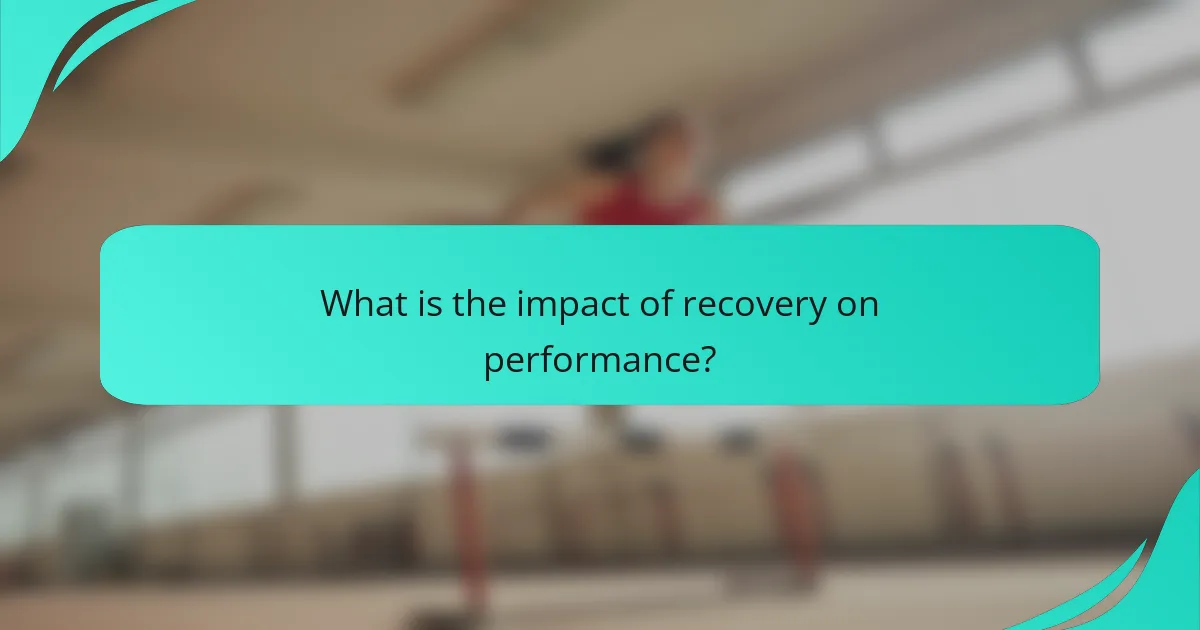
What is the impact of recovery on performance?
Recovery significantly influences overall performance by allowing the body and mind to recuperate from physical and mental exertion. Effective recovery strategies can enhance capabilities, reduce fatigue, and improve resilience during back-to-back events.
Improved physical performance
Recovery plays a crucial role in restoring muscle function and energy levels, which are vital for optimal physical performance. Techniques such as active recovery, hydration, and proper nutrition can help athletes bounce back more quickly between events.
For instance, incorporating low-intensity activities like walking or cycling can facilitate blood flow and reduce muscle soreness. Aim for at least 24 hours of recovery between intense sessions to maximize performance gains.
Enhanced mental clarity
Recovery is essential for mental sharpness, as it helps reduce stress and fatigue that can impair cognitive functions. Engaging in relaxation techniques such as meditation or deep breathing can significantly enhance focus and decision-making skills during demanding events.
Prioritizing sleep is another critical aspect; aim for 7-9 hours of quality sleep per night to support cognitive recovery. Short naps of 20-30 minutes can also provide a quick boost in alertness and performance.
Long-term health benefits
Consistent recovery practices contribute to long-term health by preventing injuries and reducing the risk of chronic conditions. Regularly allowing the body to recover can lead to improved cardiovascular health and better immune function.
Incorporating recovery days into training schedules not only enhances performance but also promotes longevity in sports. Establish a routine that includes rest days, cross-training, and flexibility exercises to maintain overall health and well-being.
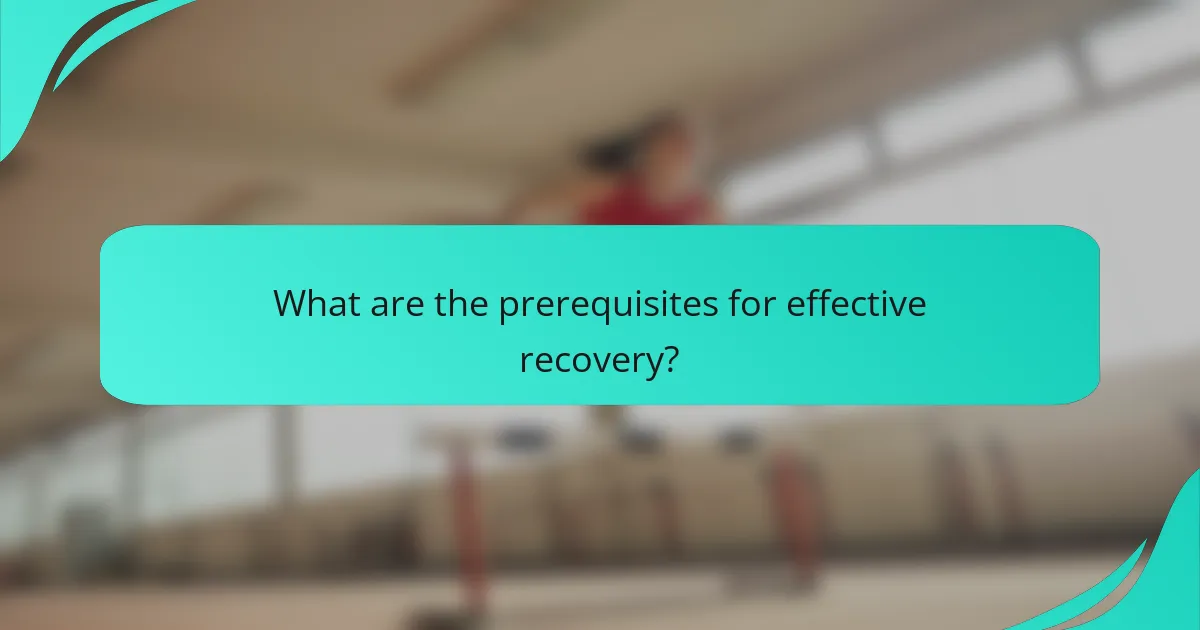
What are the prerequisites for effective recovery?
Effective recovery from back-to-back events requires understanding individual needs and assessing event intensity. Tailoring recovery strategies to these factors enhances performance and reduces fatigue.
Understanding individual needs
Each participant may have unique recovery requirements based on their physical condition, experience level, and personal preferences. Factors such as age, fitness level, and prior exposure to similar events can significantly influence recovery strategies.
For example, younger athletes might recover faster than older ones, while those with previous injuries may need additional time or specific interventions. Conducting pre-event assessments can help identify these individual needs.
Assessing event intensity
Evaluating the intensity of each event is crucial for determining appropriate recovery methods. High-intensity events typically require longer recovery periods and more comprehensive strategies compared to lower-intensity activities.
To assess intensity, consider factors like duration, physical demands, and mental stress involved. For instance, a marathon will necessitate different recovery techniques than a short sprint. A general rule is to allow at least 24 hours of recovery for every hour of high-intensity activity.
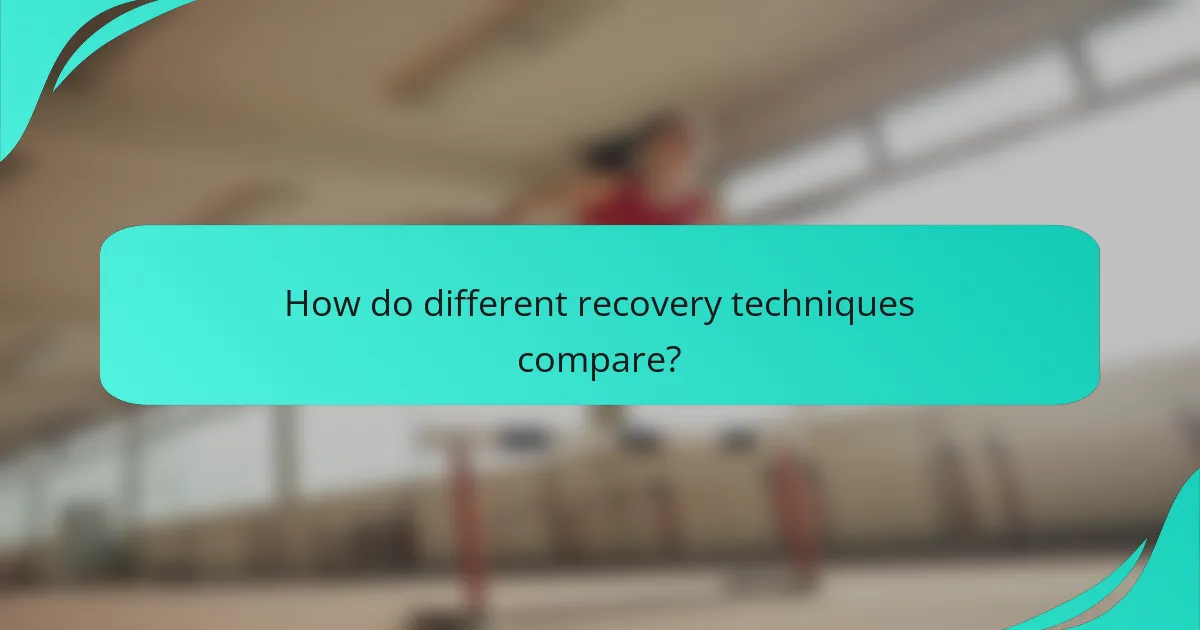
How do different recovery techniques compare?
Recovery techniques vary significantly in their approach and effectiveness, impacting performance in back-to-back events. Understanding the differences between these methods can help athletes choose the best strategies for their specific needs.
Active vs passive recovery
Active recovery involves low-intensity activities that promote blood flow and reduce muscle stiffness, such as light jogging or cycling. This method can enhance recovery by facilitating the removal of metabolic waste and delivering nutrients to muscles more effectively.
In contrast, passive recovery focuses on complete rest, allowing the body to recuperate without any physical exertion. While passive recovery can be beneficial after intense workouts, it may not be as effective in maintaining performance levels during consecutive events.
Short-term vs long-term strategies
Short-term recovery strategies are designed for immediate relief and can include techniques like stretching, hydration, and nutrition. These methods are crucial for quick recovery between events, helping to alleviate fatigue and prepare the body for the next challenge.
Long-term recovery strategies, such as regular training adjustments, sleep optimization, and consistent nutrition, focus on overall performance enhancement and injury prevention. Implementing these strategies can lead to sustained improvements in athletic performance over time, making them essential for athletes engaged in frequent competitions.
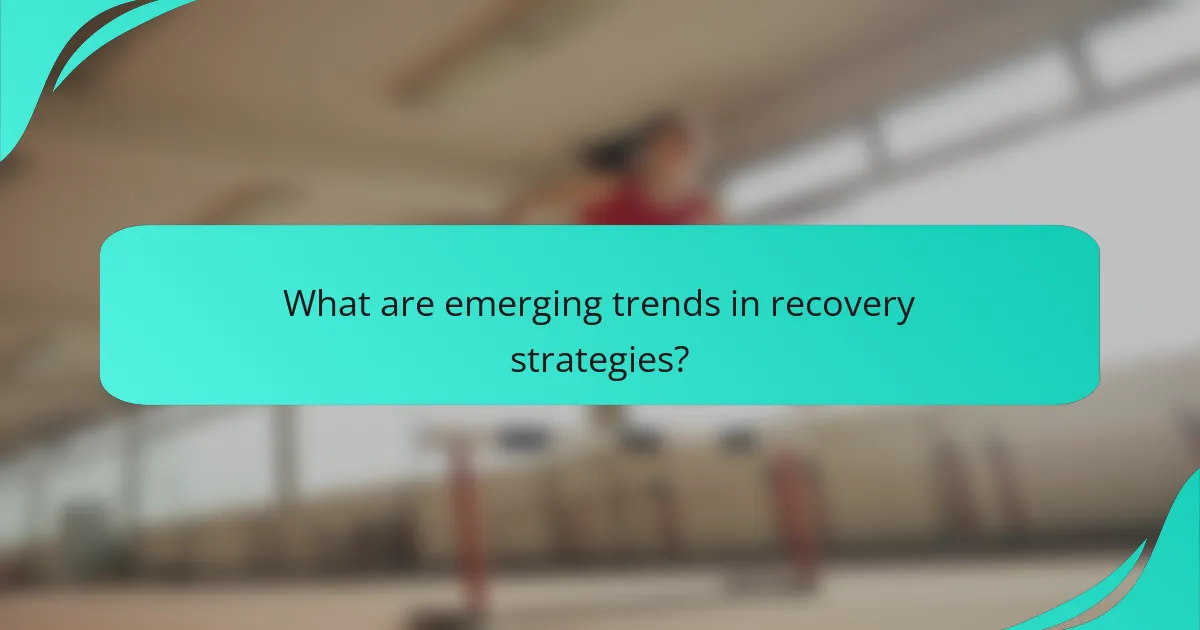
What are emerging trends in recovery strategies?
Emerging trends in recovery strategies focus on optimizing performance and minimizing downtime between back-to-back events. Techniques such as personalized recovery plans, technology integration, and holistic approaches are gaining traction.
Wearable technology for recovery tracking
Wearable technology plays a crucial role in monitoring recovery by providing real-time data on physiological metrics such as heart rate, sleep quality, and activity levels. Devices like smartwatches and fitness trackers can help athletes and individuals assess their recovery status effectively.
When selecting wearable devices, consider factors such as battery life, accuracy of data, and compatibility with other health apps. Popular options include the Apple Watch, Fitbit, and Garmin, each offering unique features tailored to different needs.
To maximize the benefits of wearable technology, set specific recovery goals based on the data collected. For instance, aim for a certain amount of deep sleep each night or monitor heart rate variability to gauge stress levels. Avoid relying solely on technology; combine insights with professional advice for a comprehensive recovery strategy.
